The Hazel Wood
Book review: The Hazel Wood by Melissa Albert (audiobook)
This review might contain spoilers.
The Hazel Wood by Melissa Albert is the first book in the new, young adult, fantasy trilogy. The moment I heard about this book, it became one of my most anticipated releases of 2018. I ordered my first Owlcrate subscription box and received an exclusive cover edition of The Hazel Wood. I was so happy!
Months later, my excitement abated a bit, but I still wanted to read the book. When I found out that Rebecca Soler narrates the audiobook version, I immediately ordered it from Audible.
Synopsis
Seventeen-year-old Alice and her mother have spent most of Alice’s life on the road, always a step ahead of the uncanny bad luck biting at their heels. But when Alice’s grandmother, the reclusive author of a cult-classic book of pitch-dark fairy tales, dies alone on her estate, the Hazel Wood, Alice learns how bad her luck can really get: her mother is stolen away―by a figure who claims to come from the Hinterland, the cruel supernatural world where her grandmother's stories are set. Alice's only lead is the message her mother left behind: “Stay away from the Hazel Wood.”
Alice has long steered clear of her grandmother’s cultish fans. But now she has no choice but to ally with classmate Ellery Finch, a Hinterland superfan who may have his own reasons for wanting to help her. To retrieve her mother, Alice must venture first to the Hazel Wood, then into the world where her grandmother's tales began―and where she might find out how her own story went so wrong.
Review
I have mixed feelings about The Hazel Wood. First of all, Rebecca’s narration is fabulous, and whatever misgivings I have about the book, they have nothing to do with the narrator.
For some reason, I expected The Hazel Wood to be like “The Darkest Part of the Forest” by Holly Black (which is one of my most favourite YA fantasy novels - I am still not over the fact that it is a stand-alone). But it is different, although, at times, especially moments about the forests and Hinterland dwellers coming through to the real world did remind me of Holly Black writing. Alice, the main protagonist, sometimes reminded me of Kate from This Savage Song by Victoria Schwab - she is a straightforward and unapologetic girl with anger management issues.
And that is the problem with The Hazel Wood - it reminded me of other books I have already read. Not too much, but enough that I felt as if the story was not original enough. I loved the idea of travelling between worlds and the book with creepy fairy tales. That is definitely something that I enjoy in stories. More so, Melissa does an excellent job at developing the plot and characters and weaving in references here and there.
The main protagonist is Alice Proserpine - her first name, obviously, refers to Alice from Wonderland, and her last name - to Proserpine (or Persephone in Ancient Greece), the ancient Roman goddess, who was kidnapped by the god of Underworld. Thankfully, Alice from The Hazelwood had a better fate than that of Persephone.
There were other literary references, multiple mentions of Kurt Vonnegut, Harry Potter, and other classics.
Alice, her mother Ella (which is short for Vanilla, by the way), her grandmother Althea - all seem to have rather sonorous names creating almost alliteration. Even, Ellery (Finch) fits into the trend.
Alice is not a likeable character, and she is not supposed to be one. But seeing as the narrative is told from her perspective, it is hard to be completely detached from her personality. I neither liked nor disliked Alice. I felt that she was well developed, but failed to make me care about her as a character. Same about the plot. The Hazel Wood failed to make me care.
The only character whom I liked was Finch. I did not like him from the very beginning, but I liked him later, for his determination and excitement about the Althea Proserpine’s book and Hinterland. He was also very sweet to Alice, and even though later we learned about some of his ulterior motives, it still does not cancel out the fact that he did a lot for her.
And she was a shitty friend in return.
Sadly, Finch’s fate turned out to be a sad one, and seeing as he was the only character of colour in the book, his mistreatment by the plot does not sit well with me. I thought about it a lot. It is possible to argue that Finch got exactly what he wanted (I can’t really say more for fear of spoiling it all), but I just don’t like the way it was delivered in the book.
There was a reference to the police mistreatment of people of colour in the book. And there was at least one canon same-sex couple. I must give it to Melissa, she did try to cross her Ts to make the book diverse and appealing to all readers, but I still found that the book was lacking in this regard as well.
I am torn. I can compare The Hazel Wood to a slightly warped mirror reflection - everything seems to be in place, but at the same something is off. I wish I loved this book, but I didn’t. I liked the wrapper but not the filling.
I still plan to continue with the series - although the ending of The Hazel Wood wrapped up so nicely, I am surprised it is not a stand-alone - I hope that since it was a debut novel, the sequel will be better.
Rating: 3 stars
More of my book reviews
I created a mood board inspired by The Hazel Wood, as it is a very atmospheric book. I made two versions - one with black and another with biracial Finch. (Since the book didn’t specify and I loved both images that I found.)
Version #1
The Hazel Wood mood board 1
Version #2
The Hazel Wood mood board 2
Book review: "The Poet X" by Elizabeth Acevedo (audiobook)
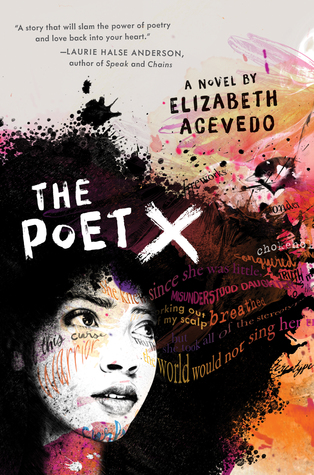
I heard of "The Poet X" on social media but didn’t think I would be interested in reading it. After devouring “Long Way Down” by Jason Reynolds, I felt that no other young adult contemporary poetry book would beat that. Unfamiliar with slam poetry, I assumed that it would be too out of my comfort zone, but when I accidentally came across the audiobook on my OverDrive, I decided to give it ago.
Synopsis
A young girl in Harlem discovers slam poetry as a way to understand her mother’s religion and her own relationship to the world. Debut novel of renowned slam poet Elizabeth Acevedo.
Xiomara Batista feels unheard and unable to hide in her Harlem neighbourhood. Ever since her body grew into curves, she has learned to let her fists and her fierceness do the talking.
But Xiomara has plenty she wants to say, and she pours all her frustration and passion onto the pages of a leather notebook, reciting the words to herself like prayers—especially after she catches feelings for a boy in her bio class named Aman, who her family can never know about. With Mami’s determination to force her daughter to obey the laws of the church, Xiomara understands that her thoughts are best kept to herself.
So when she is invited to join her school’s slam poetry club, she doesn’t know how she could ever attend without her mami finding out, much less speak her words out loud. But still, she can’t stop thinking about performing her poems.
Because in the face of a world that may not want to hear her, Xiomara refuses to be silent.
Review
To understand the impact this book had on me, you have to know two things: one - Elizabeth Acevedo is a slam poet and narrates the book herself; two - she is a daughter of Dominican immigrants, and the "The Poet X" reads in many ways as a memoir. If I were presented with this book as a completely fictitious narrative, it wouldn’t have swept me off my feet the way "The Poet X" did. Elizabeth narrates it in the way her protagonist is - blunt, emotional, unapologetic, fierce.
Brought up in a conservative family, with the mother who speaks to God more than she talks to her own daughter, and the father, who is more absent than present, Xiomara is left to tend to herself as she struggles with her blooming emotions. She is not allowed to even talk to boys. She is not allowed to speak up. She is not allowed to doubt things that she was taught. But Xiomara does all of those things, and her journey is an emotional rollercoaster.
There are so many reasons to love this book: it is written by a female poet of colour; its plot would appeal to any teen reader; there is first love, and heartbreak, and parents being cruel when trying to be kind. But my favourite thing was Elizabeth’s voice. Low and husky, it felt so tangible that it felt as if "The Poet X" was being told only to me and nobody else. It was a secret that I was made privy to.
Listening to the audiobook, I could see Xiomara in front of my eyes, scribbling fearlessly, relentlessly, in her notebook - a line after a line, a poem after a poem. I flew through this audiobook, my heart in my throat, as I desperately hoped for a happy ending for Xiomara. Few YA contemporary books make me anxious about character’s future. With "The Poet X", I wanted - no, needed - a happy ending. Too many things could go wrong, and I wished for this book to prove me wrong.
And it did.
Even though I immensely enjoyed "The Poet X", I struggled with the rating. The book is positioned as both a novel and a poetry collection, which you would not know unless you pick up a physical book. Each chapter is indeed formatted as a poem and even has a title. But listening to an audiobook felt as if it was a prose narrative through and through, except for in certain moments the author changed the tone and rhythm of her narration. I am not too familiar with slam poetry, but I have been to spoken poetry readings, and I love prose poetry, so I am a bit on the fence with this book. For me, it was mostly the prose with just a hint of poetry at times, and I wish we had gotten more rhythm, intonation and voice inflexion. All of those were present in "The Poet X" but not as much as I would have preferred given the format of the book. I wanted more of it all.
The plot and the characters are excellent, as well as the audiobook narration, but the formatting of the book seemed not to fit the idea behind it. I still loved everything about the book, but if I were a bookseller, I would be confused with whether to categorise it as a poetry collection or contemporary young adult.
If you have an option of choosing between a physical copy and an audiobook - go with the audio. Elizabeth is a professional slam poet and knows how to read her book.
My heart got squeezed so many times while I was listening to "The Poet X". It is a fabulous read, and I wish more people would be talking about it.
Highly recommend.
Rating: 4 stars
More of my book reviews
Links
AGO Exhibit: Infinity Mirrors by Yayoi Kusama
 YAYOI KUSAMA: INFINITY MIRRORS
March 3 – May 27, 2018
YAYOI KUSAMA: INFINITY MIRRORS
March 3 – May 27, 2018
Information about the artist and the exhibit are taken from Art Gallery of Ontario website. All photos and opinions are mine.
Guided by her unique vision and unparalleled creativity, critically acclaimed artist Yayoi Kusama has been breaking new ground for more than six decades. In 1993, she became the first woman to have a solo presentation at the Venice Biennale’s Japanese Pavilion, and in 2016, Time magazine named her one of the world’s most influential people.
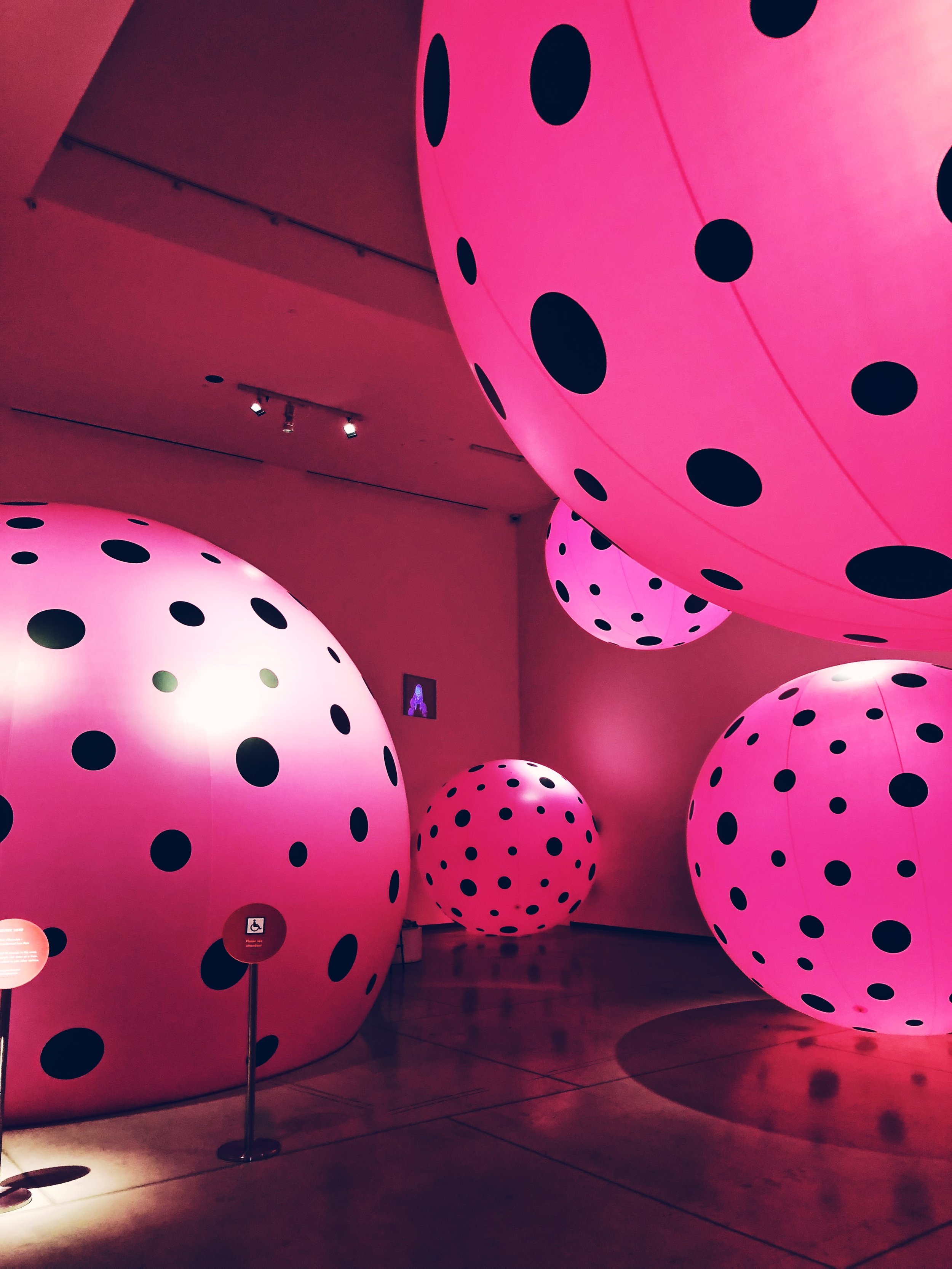
Born in 1929, Kusama grew up near her family’s plant nursery in Matsumoto, Japan. At nineteen, following World War II, she went to Kyoto to study the traditional Japanese style of painting known as Nihonga. During this time, she began experimenting with abstraction, but it was not until she arrived in the United States, in 1957, that her career took off. Living in New York from 1958 to 1973, Kusama moved in avant-garde circles with such figures as Andy Warhol and Allan Kaprow while honing her signature dot and net motifs, developing soft sculpture, creating installation-based works, and staging Happenings (performance-based events). She first used the mirror as a multi-reflective device in Infinity Mirror Room—Phalli’s Field, 1965, transforming the intense repetition that marked some of her earlier works into an immersive experience. Kusama returned to Japan in 1973 but has continued to develop her mirrored installations, and over the years, she has attained cult status, not only as an artist, but as a novelist.

Experience infinity: From her immersive infinity rooms to mesmerizing paintings and playful sculptures, Yayoi Kusama welcomes you to participate in her extraordinary and innovative explorations of time and space.

Infinity may be a difficult concept to grasp, but it is easy to contemplate when you step inside one of artist Yayoi Kusama’s iconic Infinity Mirror Rooms in the exhibition Yayoi Kusama: Infinity Mirrors. Rich with key works from the contemporary Japanese artist’s significant 65-year career, this major exhibition also shows the evolution of her immersive, multi-reflective installations, in which she invites you to share in her unique vision.

Immerse yourself in six of these kaleidoscopic environments where you will be endlessly reflected within fantastic landscapes. You’ll also see Kusama’s mesmerizing and intimate drawings, her early Infinity Net paintings in which nets organically expand along the surface of a canvas like cell formations, and her surreal sculptural objects. These key works join more than 90 works on view, including large and vibrant paintings, sculptures, works on paper, as well as rare archival materials.

The 88-year-old artist continues to work at a brisk pace in her Tokyo studio. The exhibition features the North American debut of numerous new works. Her most recent painting series, My Eternal Soul (2009–present), may be the greatest surprise. Exuberant in colour and paired with sculptures that bear titles such as My Adolescence in Bloom, they mark a striking progression in the use of Kusama’s signature symbol of the polka dot. Also on view in North America for the first time is the recently realized Infinity Mirror Room, All the Eternal Love I Have for the Pumpkins, 2016 , a field of yellow, dotted pumpkins spreading into infinity.

In addition to the paintings, sculptures, drawings and environments, viewers will encounter posters, letters, cards, and invitations that relate to Kusama’s early exhibitions and events—including her first solo show, which took place in Seattle—a slideshow of Kusama’s performances as well as an interview with the artist filmed on the occasion of this exhibition.

Thoughts
I do not consider myself to be an expert in any art, but Infinity Mirrors by Kusama made me think about how the art has evolved over the years with the world. Lights, mirrors, stuffed tubers, lanterns, and big polka dot balls wouldn't seem to be such appealing art objects were they not presented in small rooms, in which only few people are admitted at a time, and what a short time it is! Twenty to thirty seconds with an art installation is barely enough to make an impression of it, less so to take a selfie. And this is what it's been, really - people rushing to see Infinity Mirrors only to post their moving and still photos on Snapchat and Instagram, feeding to the popularity of the exhibit.

The lack of supply increases the value of the product. People, myself included, are willing to stand in lines to each little room for the sake of spending less than a minute inside a kaleidoscopic environment. It is crazy when you think about it.
One of my favourites was the only room where we were not allowed to take pictures. And that was "All the Eternal Love I Have for the Pumpkins" - those pumpkins were gorgeous. And now I want a nightlamp shaped as one.

The last installation was a simple white room that invites the audience to deface it - it was fun but did not feel new or original enough. Although seeing how high up some visitors were willing to go was fun on its own.
My dots are hiding somewhere here, invisible among all others.

"Infinity Mirrors" really stretched my depth perception. One room had flashing lights. The polka dots hurt my eyes when I was trying to edit the photos. This exhibit was a sensory overload - so, I suggest you proceed with caution if you do not do well with that. My constant fear was - since in every room except for the last one, we were either in the dark or on a narrow catwalk - that I might lose balance and fall into the art.
Would I have become a part of the exhibit?
May 17, 2018
More photos by me
Book review: "The Scorpion Rules" (Prisoners of Peace #1) by Erin Bow
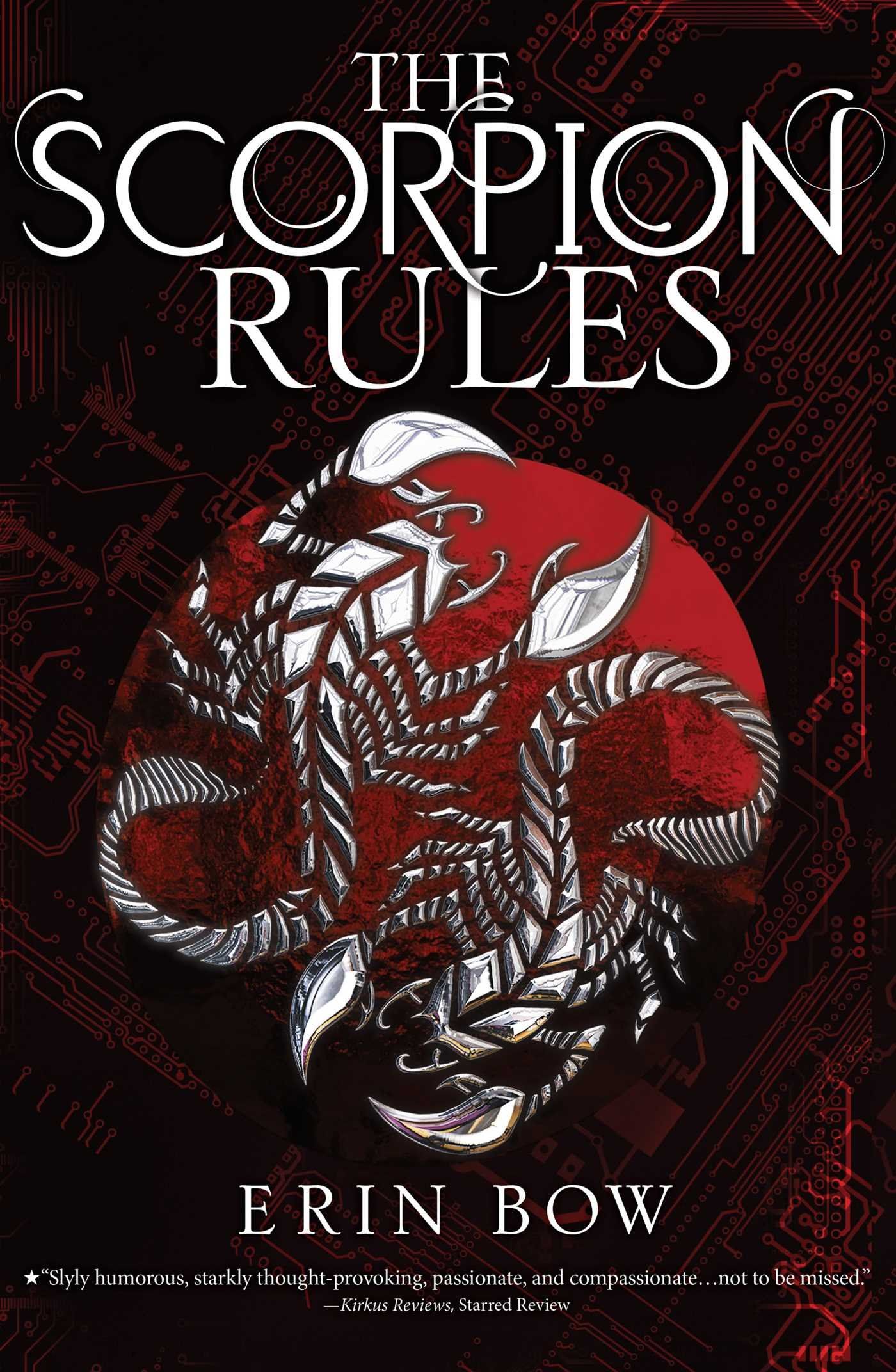
I purchased “The Scorpion Rules” back in a day when it came out in this gorgeous paperback. I saw this book mentioned again and again in YA LGBTQ+ recommendations and was excited to read it. But as it often happens with impulse purchases, I didn’t pick up the book until much later.
I was quite in the mood for a YA Sci-Fi audiobook after listening to Nyxia, and while browsing Overdrive library, I saw that “The Scorpion Rules” was immediately available.
I downloaded it to my iPhone and started listening to it right away. I had only a vague recollection of the plot of “The Scorpion Rules” from the back of the book. I knew that the book had diverse characters, was generally considered to be sci-fi, and was somehow related to Canada. For the sake of accurate spelling of names, I am providing the official synopsis below.
Synopsis
A world battered by climate shift and war turns to an ancient method of keeping peace: the exchange of hostages. The Children of Peace - sons and daughters of kings and presidents and generals - are raised together in small, isolated schools called Prefectures. There, they learn history and political theory, and are taught to gracefully accept what may well be their fate: to die if their countries declare war.
Greta Gustafsen Stuart, Duchess of Halifax and Crown Princess of the Pan-Polar Confederation, is the pride of the North American Prefecture. Learned and disciplined, Greta is proud of her role in keeping the global peace — even though, with her country controlling two-thirds of the world’s most war-worthy resource — water — she has little chance of reaching adulthood alive.
Enter Elián Palnik, the Prefecture’s newest hostage and biggest problem. Greta’s world begins to tilt the moment she sees Elián dragged into the school in chains. The Prefecture’s insidious surveillance, its small punishments and rewards, can make no dent in Elián, who is not interested in dignity and tradition, and doesn’t even accept the right of the UN to keep hostages.
What will happen to Elián and Greta as their two nations inch closer to war?
Review
I listened to “The Scorpion Rules” for about 10 minutes, paused and went online to look up the narrator. The audiobook is narrated by Madeleine Maby, who, judging by her website and extensive Audible presence, is a rather experienced voice actor. I was not impressed though at all. Madeleine gives all characters distinctive voices, but her intonation is clipped and artificial. (There were mentions of accents in the book, but it still didn’t make much sense to me.) I would have understood if she narrated for AI in that manner, but it was all of the characters in different variations. I found the narration for Greta the most annoying as she talked in the way that Siri or an artificial intelligence might, with odd stops between words and occasional uprise in intonation. Elian’s southern accent came and went, and seemed to be more prominent whenever there was a line in the book referring to it.
I was so not impressed by the narration, that I even considered switching to a paper book. However, I decided to stick to the audiobook as I wanted to listen to something during the commute or work breaks. Getting over the narration style was a bit difficult, but I somewhat got used to it by the end of the book.
Now, onto the plot. Sadly, I was somewhat disappointed by it too. I think “The Scorpion Rules” is more character driven than plot driven, which is usually fine by me, but not in this case. It took awhile for me to get into the plot. The first third of the book, I was bored and couldn’t figure out why things were the way they were. There is a lot of exposition in the book, which I do not like. We have even quotes and reciting from the AI that at times seemed a bit unfitting to the main narrative. I enjoyed the world but didn’t like the fact that I could barely make head or tail of local politics, not to mention rivalries and alliances between countries.
Regarding characters, I liked Michael the best, from the moment he made an appearance. Everything about him, his character, the circumstances of his arrival, the complications, etc. - I liked everything. But regardless of role in the plot of “The Scorpion Rules”, Greta and Elian were the main protagonists (which is confirmed in the synopsis), and I did have a lot of problems with both of them.
Greta seemed too plain to be anything special, and yet she was. She was too all over the place in her emotions and affections, and yet she was described as exceptional and strong. Elian seemed perpetually confused and rebellious, even when nothing was happening to warrant either. I could not understand Greta’s feelings towards Elian. She viewed him as someone who needs care and protection and at the same time - as someone dangerous.
There are a lot of descriptions in the text of what characters felt, lots of comparisons - the language flows most of the time quite wonderfully. However, I often felt that the lack of actual reasoning and plot holes were being hidden behind grand statements about life and sacrifice and characters’ feelings. We were often being told that something was happening just because it was happening. I would have been able to oversee it if there was more action, but too frequently it felt as if nothing was moving at all. And when something was happening, we were not really told why. At times, I could feel my mind drifting, as I was almost bored with the book. Perhaps, it is once again the fault of the narrator, who failed to make “The Scorpion Rules” sound engaging enough.
“The Scorpion Rules” disappointed me from the standpoint of LGBTQ+ representation too. The book is tagged and listed on GoodReads as having prominent LGBTQ+ characters, however, the only female/female relationship proved not to be strong enough to overcome the obstacles (add to that a cliched presence of a male protagonist - obviously), and the only male/male couple was not given any visibility until the tragic end. Yes, we get various sexualities in the book, and there is some sort of a gender swap, so to say, which can be viewed as gender dysphoria almost, but I am hesitant to say that it can be viewed as a representation for genderfluid or transgender people. Perhaps, it was not intended as either at all, and it was my wishful thinking trying to find more representation in the book.
The Children of Peace and Swan Riders come from various countries and therefore from different racial and cultural backgrounds. I liked that about “The Scorpion Rules”. In my opinion, the cultural representation was handled well.
Perhaps, if I approached “The Scorpion Rules” in physical format, I would have connected with the characters better. Unfortunately, I finished the audiobook feeling somewhat cheated. I didn’t get the representation I was looking for; the plot was murky; the characters - annoying, and the only thing that I liked about the novel - the world itself - was presented to us through obvious exposition, which often felt detached from the plot.
I like “The Scorpion Rules” much more as an idea for a book or a sales pitch, as opposed to the actual result. I can’t tell if it is the writing style that I have more problems with or the narration of the audiobook - or, maybe, both. “The Scorpion Rules”, as well as some other books by Erin Bow, received favourable reviews from multiple sources and was even listed in Kirkus Reviews Best Teen Books of 2015. I still decided to continue with the series, in spite of feeling disappointed by the first book.
Rating: 3 stars
More of my book reviews
Links
- https://www.goodreads.com/book/show/28487395-the-scorpion-rules
- https://www.erinbow.com
- https://www.madeleinemaby.com/
Book review: "Big Magic: Creative Living Beyond Fear" by Elizabeth Gilbert
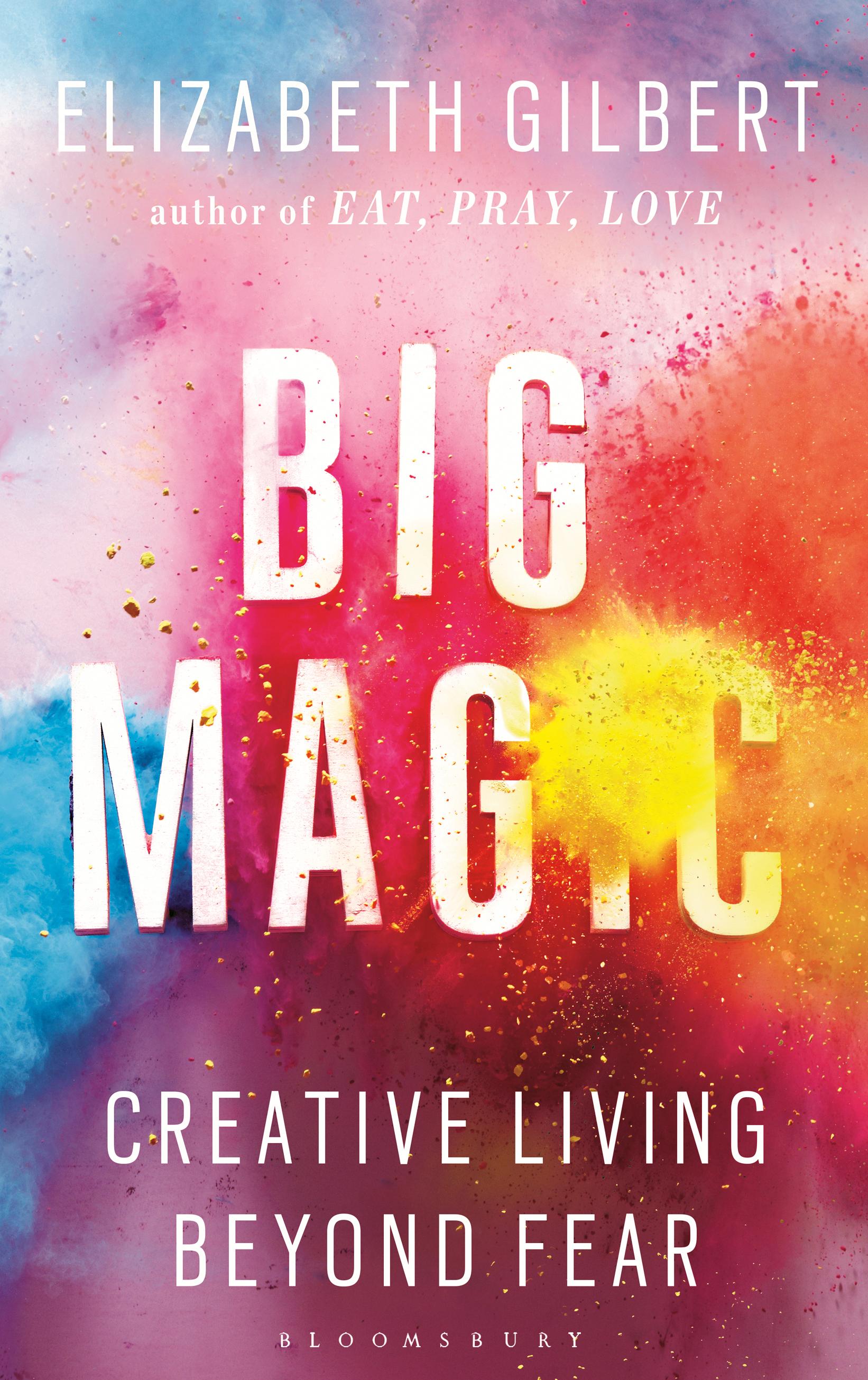
Years ago, when Elizabeth Gilbert’s "Eat, Pray, Love" came out and everyone was obsessing over that book and then the movie, I, honestly, could not care less. I was far from being thirty-something, experiencing a mid-life crisis, or interested in a self-discovering journey across the world. More so, I was turned away by the title that sounded too "privileged, rich, devoted Christian, American" to me, when I was neither of those things.
I made assumptions about the author and her books and steered away from both.
Once “Big Magic” came out, it seemed as if it was everywhere: in stores, on people’s Instagram accounts, on recommendations lists. I was getting tired of being recommended the book by the author, who was so very much unlike me.
Finally, almost against my own will, I checked out a copy of “Big Magic” from the library. I wanted to see for myself what the fuss was all about. I won’t pretend that I didn’t ignore the book on my shelf for a few weeks until I finally picked it up.
Now let me be clear here. I am not a huge fan of non-fiction books - it is probably the only genre I would never voluntarily pick up to read. With “Big Magic”, I decided that I needed to read it if only to be able to tell people if asked, that I read it and hated it.
And then a strange thing happened.
I did not hate it. At all. The realization of that left me a bit stunned.
A decade ago, I was too young to sympathize with the author or the life hurdles she might have gone through at the time. Now, being same age as Elizabeth at the time of “Eat, Pray, Love” (which is referenced in “Big Magic” a lot), I found myself less opposed to the idea of reading about another woman’s journey and self-rediscovery.
“Big Magic” is both a self-help book and a memoir. It is a curious blend of things that Elizabeth discovered herself about her writing and creative process and the things she learned from others. Where I expected the book to be patronizing - it is written by the award-winning and bestselling author after all - it was very humble; where I expected it to be complicated, it was lighthearted in tone; where I thought I would hate it - I liked it enough to order my own copy.
I can’t call “Big Magic” revolutionary or eye-opening. It was, however, entertaining and inspiring in its way. I felt less alone, when I read about Elizabeth’s writing process, the ideas that come and go, and inspiration behind her books. How some of her works, however, do not do very well. How she also struggles with mental illnesses. How she had to make sacrifices in her life.
Suddenly, I could fully understand Elizabeth Gilbert, and it took me by surprise. It seems I had to grow up to appreciate her work.
I am looking forward to receiving my copy of “Big Magic” as I want to go through the book again and underline all of my favourite quotes. I picked up this book when I was not feeling well and needed some light reading, and it turned out that I needed to read “Big Magic”. I can’t claim that it pulled me out of my funk completely, but it certainly helped.
Even if you consider yourself to be the most uncreative person ever, I still recommend you read this book. If you hate memoirs - as I do - still read this book as it is not a dry recounting of past events but a lively and engaging story. If you scoff at self-help books - I will still suggest you give “Big Magic” a go, as this book is much better than many self-help books out there, especially if you consider yourself to at least somewhat creative.
I am very happy that I gave “Big Magic” a chance, even though it was initially for wrong reasons.
Rating: 3.5 stars
More of my book reviews
Links:
Book review: "I left nothing inside on purpose" by Stevie Howell
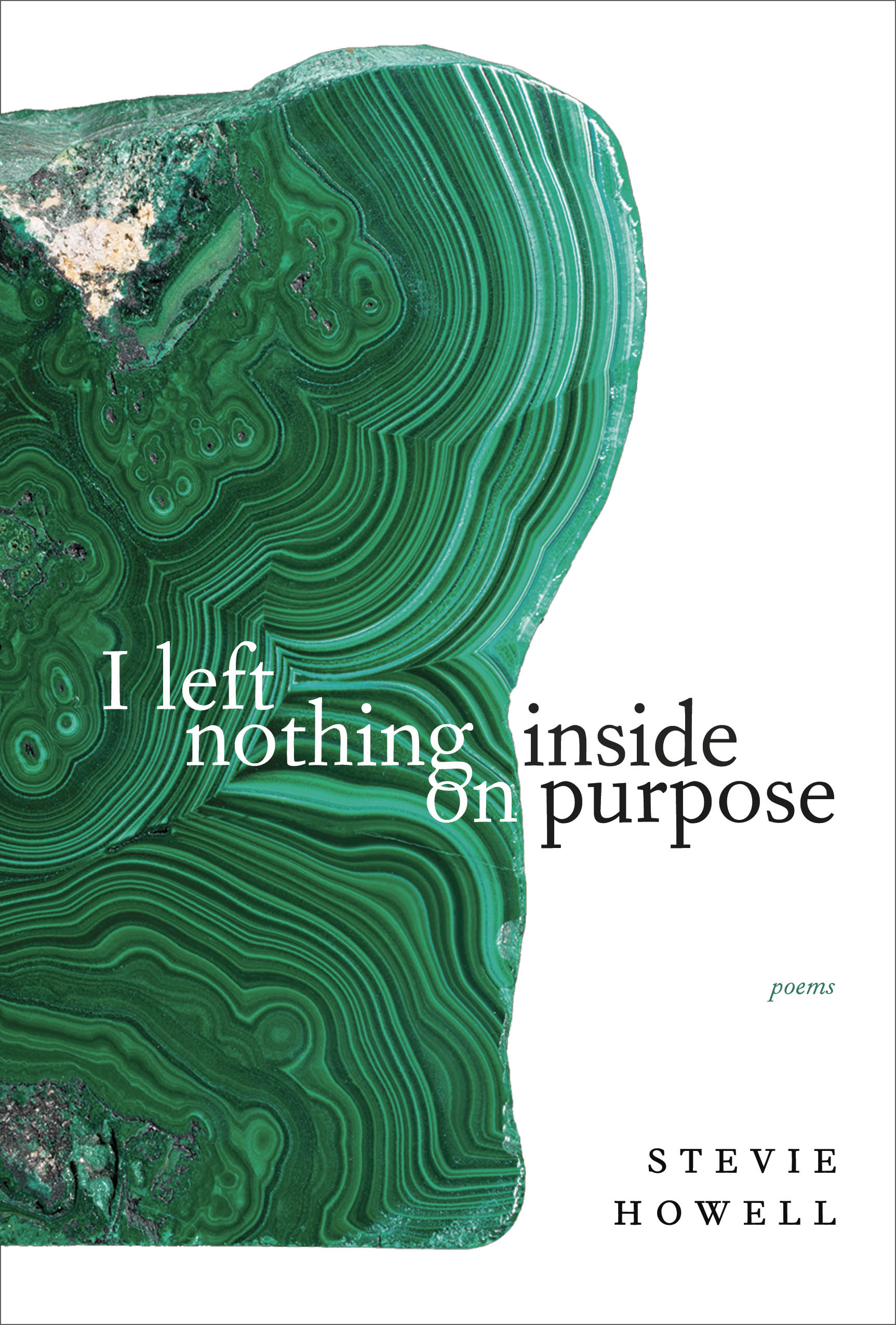
I received a copy of "I left nothing inside on purpose" by Stevie Howell from Penguin Random House Canada in exchange for a free and honest review.
I was attracted to this poetry collection by its title and cover. I admit that I had not heard of Stevie Howell before receiving the book, but as I would like to educate myself more on contemporary Canadian writers and poets, I was excited to read this collection.
About author
Stevie Howell is an Irish-Canadian writer & editor. A first collection of poetry, Sharps (Goose Lane, 2014), was a finalist for the Gerald Lampert Memorial Award. A second book, I left nothing inside on purpose, is forthcoming spring 2018 from Penguin Random House Canada.
Stevie’s poetry has appeared in The Best Canadian Poetry, Hazlitt, The Walrus, Geist, Eighteen Bridges, & Maisonneuve; in U.S. publications including BOAAT, Prelude, Prairie Schooner, The Cossack Review, Gigantic Sequins, & The Best American Poetry site; & in Irish & U.K. publications including The Rialto, The Moth, Southword, & Banshee. Their critical writing has been published in Ploughshares, The Rumpus, National Post, The Globe & Mail, & Quill & Quire.
Stevie is the poetry editor at This Magazine, an MFA candidate in creative writing at NYU, & lives in Brooklyn.
Review
"I left nothing inside on purpose" blew me away. Considering the size of the book - just a handful of pages - I expected myself to breeze through it. Instead, I spent almost a month going through it page by page, discovering more and more hidden gems between broken lines and slanted dashes.
Rich in symbolism and intricate in its form, Stevie’s poetry made me pause over and over to reassess what I was reading and feeling. I will be honest - it took me some time to get used to slashes and ampersands, but by the end of the book, I couldn’t imagine it being any other way.
I love books that make me take a moment and think. More so, I love books that make me google things that I don’t know as it does not happen very often (for example, an extraordinary case and life of Clive Wearing). Reading "I left nothing inside on purpose" felt like going on a long voyage: suffering from the unyielding heat, experiencing thirst and hunger, facing danger, making unlikely friends, and finally reaching the desired shores, weathered and more experienced than before. I am certain that this poetry collection is going to be a book I keep returning to, as I feel as if I have not explored all of its depths.
I kept delaying writing this review as I felt - and still feel - unequipped to review something so intricate and sophisticated. As always, in cases of the books that make me feel inadequate and simple, I suggest that you pick up a copy of "I left nothing inside on purpose" and read it for yourself. Dissecting and analyzing Stevie’s poems feels blasphemous.
Whatever misconceptions or prejudices you might have against contemporary poetry (something I can not relate to at any level), do consider giving “I left nothing inside on purpose” a go. It has to be experienced on your own.
Highly recommend.
Rating: 4.5 stars
More of my book reviews
Links
- https://www.goodreads.com/book/show/35629988-i-left-nothing-inside-on-purpose
- http://steviehowell.ca
- https://penguinrandomhouse.ca/books/551303/i-left-nothing-inside-purpose
Book review: "The Josephine Knot" by Meg Braem
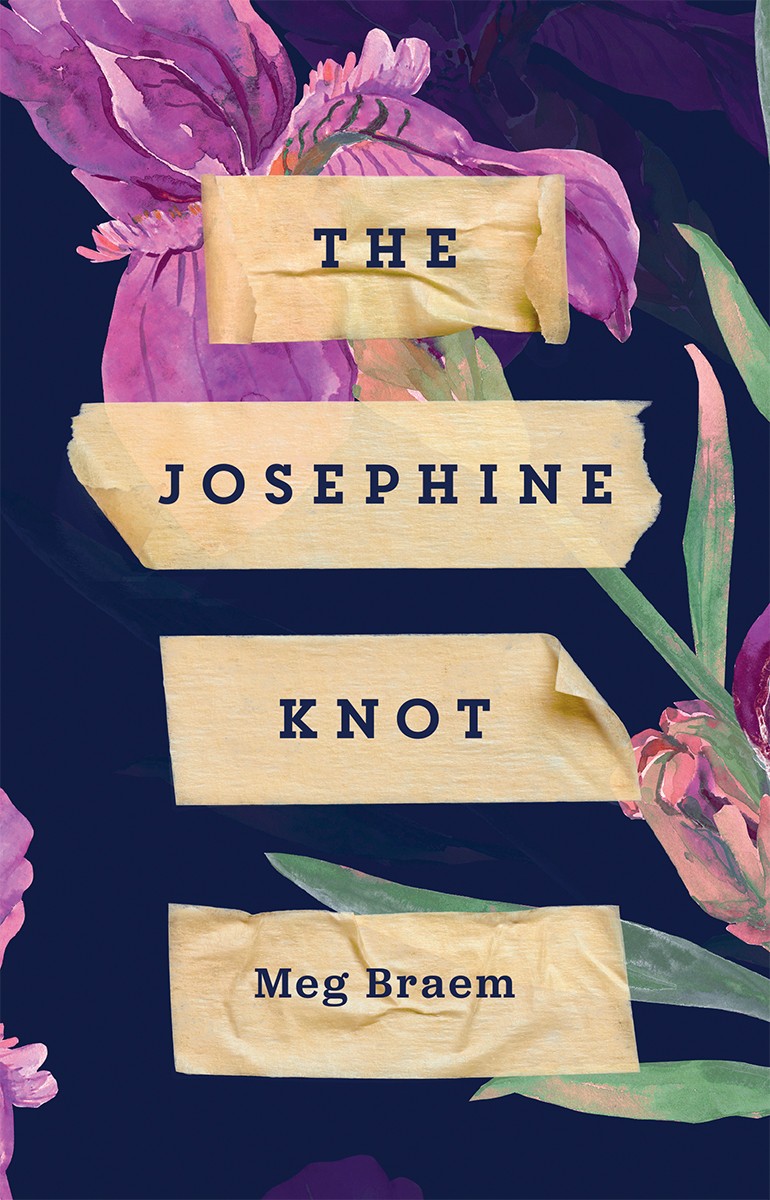
The Josephine Knot is one of the 2018 releases by Playwrights Canada Press, and I received a copy of this play in exchange for a free and honest review.
Synopsys
The author of Blood: A Scientific Romance is back with a story in which a family must pack up a matriarch’s things while unpacking the past and untangling the present.
After Samantha’s baba dies, her fractured family is summoned to pick through the house full of belongings and trash, leaving taped notes on whatever they want to take. Between old napkins, a closet full of ketchup packets, and a freezer full of rotting meat are gems like a grandfather clock and plastic deer statuettes that hold more sentiment. While her father David sifts through his own memories, all Samantha wants is to find a simple object that could represent her place in the family. When other family members arrive, tug of wars and passive-aggressive conversations commence. In a house full of junk and sadness, it comes down to Samantha and David to find a new way to fit together.
Review
A bit funny and a bit chilling, The Josephine Knot is the perfect blend of both - living up to its title to a T. Unlike with some plays and short fiction, with which I struggle to envision everything happening as it would on stage, I had no such problems with The Josephine Knot - it sucked me in from the very beginning, and there was a reason for that.
Reading this play, I felt as if I was reading about my own family’s story. The similarities are so uncanny that I felt almost creeped out by it. My name may not be Samantha, and my dad is not David, but my grandma was undoubtedly the baba from the story. With an apartment full of porcelain figurines, with the dubious cooking habits and a bad leg, my baba was as much of tour de force as Samantha’s grandmother. And as the character in the play, she was often at the heart of the family drama, leaving, even in her passing, some unresolved issues and a property to be divided among family members.
I was both fascinated and petrified by the fact that the playwright, Meg Braem, unknowingly, managed to perfectly capture the story of my dad’s family. However, obviously, many family dramas are similar, and I do not claim any privilege rights to a grandmother named Olga.
I can find no faults with The Josephine Knot. Reviewing it almost feels as if I am trying to pass judgement onto my own family. The blend of dark humour in the face of family drama, macabre details, heartbreaking revelations - you need to read the play to understand the whirlpool of emotions that I experienced when reading the play. It is very true to life, lively, and inspirational, in spite of the topic of death.
If I am ever someone important enough to warrant a biography written about me, I would like Meg Braem to do that. She, apparently, knows what she is doing.
About author
Meg Braem’s plays have won the Gwen Pharis Ringwood Award for Drama at the Alberta Literary Awards and the Alberta Playwriting Competition, and Blood: A Scientific Romance was nominated for a Governor General’s Literary Award for Drama. Her work has been presented at the Citadel Theatre, Theatre Calgary, Lunchbox Theatre, the Belfry Theatre, Sage Theatre, Sparrow & Finch Theatre, Theatre Transit, Atomic Vaudeville, and Intrepid Theatre. She is a past member of the Citadel Playwrights Forum and was a playwright-in-residence at Workshop West Playwrights’ Theatre. Her next book, Feminist Resistance: A Graphic Approach (co-authored with Norah Bowman and Domique Hui), will be published by University of Toronto Press in 2019. Meg currently divides her time between Edmonton as the Lee Playwright in Residence at the University of Alberta and Calgary as the co-director of the Alberta Theatre Projects Playwrights Unit.
Rating: 4.5 stars
More of my book reviews






